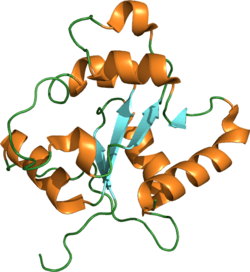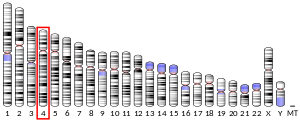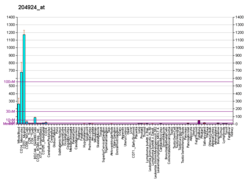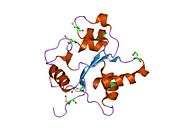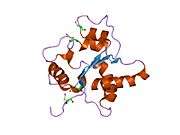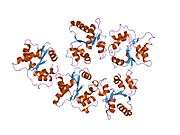TLR2
Toll-like receptor 2 also known as TLR2 is a protein that in humans is encoded by the TLR2 gene.[5] TLR2 has also been designated as CD282 (cluster of differentiation 282). TLR2 is one of the toll-like receptors and plays a role in the immune system. TLR2 is a membrane protein, a receptor, which is expressed on the surface of certain cells and recognizes foreign substances and passes on appropriate signals to the cells of the immune system.
Function
The protein encoded by this gene is a member of the Toll-like receptor (TLR) family, which plays a fundamental role in pathogen recognition and activation of innate immunity. TLRs are highly conserved from Drosophila to humans and share structural and functional similarities. They recognize pathogen-associated molecular patterns (PAMPs) that are expressed on infectious agents, and mediate the production of cytokines necessary for the development of effective immunity. The various TLRs exhibit different patterns of expression. This gene is expressed most abundantly in peripheral blood leukocytes, and mediates host response to Gram-positive bacteria[6] and yeast via stimulation of NF-κB.[7]
In the intestine, TLR2 regulates the expression of CYP1A1,[8] which is a key enzyme in detoxication of carcinogenic polycyclic aromatic hydrocarbons such as benzo(a)pyrene.[9]
Background
The immune system recognizes foreign pathogens and eliminates them. This occurs in several phases. In the early inflammation phase, the pathogens are recognized by antibodies that are already present (innate or acquired through prior infection; see also cross-reactivity). Immune-system components (e.g. complement) are bound to the antibodies and kept near, in reserve to disable them via phagocytosis by scavenger cells (e.g. macrophages). Dendritic cells are likewise capable of phagocytizing but do not do it for the purpose of direct pathogen elimination. Rather, they infiltrate the spleen and lymph nodes, and each presents components of an antigen there, as the result of which specific antibodies are formed that recognize precisely that antigen.
These newly formed antibodies would arrive too late in an acute infection, however, so what we think of as "immunology" constitutes only the second half of the process. Because this phase would always start too late to play an essential role in the defense process, a faster-acting principle is applied ahead of it, one that occurs only in forms of life that are phylogenetically more highly developed.
What are called pattern-recognition receptors come into play here. This refers to receptors that recognize the gross, primarily structural features of molecules not innate to the host organism. These include, for example, lipids with a totally different basic chemical structure. Such receptors are bound directly to cells of the immune system and cause immediate activation of their respective nonspecific immune cells.
A prime example of such a foreign ligand is bacterial endotoxin, whose effects have been known for generations. When it enters the bloodstream it causes systematic activation of the early-phase response, with all the side effects of septic shock. This is known in the laboratory as the Shwartzman phenomenon. The intended effect is to mobilize the organism for combat, so to speak, and eliminate most of the pathogens.
Mechanism
As a membrane surface receptor, TLR2 recognizes many bacterial, fungal, viral, and certain endogenous substances. In general, this results in the uptake (internalization, phagocytosis) of bound molecules by endosomes/phagosomes and in cellular activation; thus such elements of innate immunity as macrophages, PMNs and dendritic cells assume functions of nonspecific immune defense, B1a and MZ B cells form the first antibodies, and specific antibody formation gets started in the process. Cytokines participating in this include tumor necrosis factor-alpha (TNF-α) and various interleukins (IL-1α, IL-1β, IL-6, IL-8, IL-12). Before the TLRs were known, several of the substances mentioned were classified as modulins. Due to the cytokine pattern, which corresponds more closely to Th1, an immune deviation is seen in this direction in most experimental models, away from Th2 characteristics. Conjugates are being developed as vaccines or are already being used without a priori knowledge.
A peculiarity first recognized in 2006 is the expression of TLR2 on Tregs (a type of T cell), which experience both TCR-controlled proliferation and functional inactivation. This leads to disinhibition of the early inflammation phase and of specific antibody formation. Following a reduction in pathogen count, many pathogen-specific Tregs are present that, now without a TLR2 signal, become active and inhibit the specific and inflammatory immune reactions (see also TNF-β, IL-10). Older literature that ascribes a direct immunity-stimulating effect via TLR2 to a given molecule must be interpreted in light of the fact that the TLR2 knockouts employed typically have very few Tregs.
Functionally relevant polymorphisms are reported that cause functional impairment and thus, in general, reduced survival rates, in particular in infections/sepsis with Gram-positive bacteria.
Signal transduction is depicted under Toll-like receptor.
Expression
TLR2 is expressed on microglia, Schwann cells, monocytes, macrophages, dendritic cells, polymorphonuclear leukocytes (PMNs or PMLs), B cells (B1a, MZ B, B2), and T cells, including Tregs (CD4+CD25+ regulatory T cells). In some cases, it occurs in a heterodimer (combination molecule), e.g., paired with TLR-1 or TLR-6. TLR2 is also found in the epithelia of air passages, pulmonary alveoli, renal tubules, and the Bowman's capsules in renal corpuscles. TLR2 is also expressed by intestinal epithelial cells and subsets of lamina propria mononuclear cells in the gastrointestinal tract [10] . In the skin, it is found on keratinocytes and sebaceous glands; spc1 is induced here, allowing a bactericidal sebum to be formed.
Cancer
TLR2 gene has been observed progressively downregulated in Human papillomavirus-positive neoplastic keratinocytes derived from uterine cervical preneoplastic lesions at different levels of malignancy.[11] For this reason, TLR2 is likely to be associated with tumorigenesis and may be a potential prognostic marker for uterine cervical preneoplastic lesions progression.[11]
Agonists
The following ligands have been reported to be agonists of the toll-like receptor 2:
| Agonist | Organism |
| Lipoteichoic acid | Gram-positive bacteria |
| atypical LPS | Leptospirosis and Porphyromonas gingivalis |
| MALP-2 and MALP-404 (lipoproteins) | Mycoplasma |
| - | Chlamydophila pneumoniae |
| OspA | Borrelia burgdorferi (Lyme disease) |
| Porin | Neisseria meningitidis, Haemophilus influenzae |
| Antigen mixtures | Cutibacterium acnes |
| LcrV | Yersinia |
| Lipomannan | Mycobacterium: Mycobacterium tuberculosis |
| GPI anchor | Trypanosoma cruzi |
| Lysophosphatidylserine | Schistosoma mansoni |
| Lipophosphoglycan (LPG) | Leishmania major |
| Glycophosphatidylinositol (GPI) | Plasmodium falciparum |
| Zymosan (a beta-glucan) | Saccharomyces cerevisiae |
| - | Malassezia (commensal yeast) |
| Antigen mixtures | Aspergillus fumigatus, Candida albicans |
| hsp60, as peptide transporter and adjuvant for antigen presentation | - |
| Glycoprotein (gH/gL, gB)[12] | Herpes simplex virus |
| - | Varicella zoster virus |
| - | Cytomegalovirus (CMV) |
| Hemagglutinin | Measles |
Interactions
Protein-ligand interactions
TLR2 resides on the plasma membrane where it responds to lipid-containing PAMPs such as lipoteichoic acid and di- and tri-acylated cysteine-containing lipopeptides. It does this by forming dimeric complexes with either TLR 1 or TLR6 on the plasma membrane.[15] TLR2 interactions with malarial glycophosphatidylinositols of Plasmodium falciparum was shown[16] and a detailed structure of TLR–GPI interactions was computationally predicted.[17]
Gene polymorphisms
Various single nucleotide polymorphisms (SNPs) of the TLR2 have been identified [18] and for some of them an association with faster progression and a more severe course of sepsis in critically ill patients was reported.[19] No association with occurrence of severe staphylococcal infection was found.[20]
References
- GRCh38: Ensembl release 89: ENSG00000137462 - Ensembl, May 2017
- GRCm38: Ensembl release 89: ENSMUSG00000027995 - Ensembl, May 2017
- "Human PubMed Reference:". National Center for Biotechnology Information, U.S. National Library of Medicine.
- "Mouse PubMed Reference:". National Center for Biotechnology Information, U.S. National Library of Medicine.
- Rock FL, Hardiman G, Timans JC, Kastelein RA, Bazan JF (January 1998). "A family of human receptors structurally related to Drosophila Toll". Proceedings of the National Academy of Sciences of the United States of America. 95 (2): 588–93. doi:10.1073/pnas.95.2.588. PMC 18464. PMID 9435236.
- Borrello S, Nicolò C, Delogu G, Pandolfi F, Ria F (2011). "TLR2: a crossroads between infections and autoimmunity?". International Journal of Immunopathology and Pharmacology. 24 (3): 549–56. doi:10.1177/039463201102400301. PMID 21978687.
- "Entrez Gene: TLR2".
- Do KN, Fink LN, Jensen TE, Gautier L, Parlesak A (2012). "TLR2 controls intestinal carcinogen detoxication by CYP1A1". PLOS ONE. 7 (3): e32309. doi:10.1371/journal.pone.0032309. PMC 3307708. PMID 22442665.
- Uno S, Dalton TP, Dragin N, Curran CP, Derkenne S, Miller ML, Shertzer HG, Gonzalez FJ, Nebert DW (April 2006). "Oral benzo[a]pyrene in Cyp1 knockout mouse lines: CYP1A1 important in detoxication, CYP1B1 metabolism required for immune damage independent of total-body burden and clearance rate". Molecular Pharmacology. 69 (4): 1103–14. doi:10.1124/mol.105.021501. PMID 16377763.
- Cario E (Nov 2008). "Barrier-protective function of intestinal epithelial Toll-like receptor 2". Mucosal Immunology. Suppl 1: S62-6. doi:10.1038/mi.2008.47. PMID 19079234.
- Rotondo JC, Bosi S, Bassi C, Ferracin M, Lanza G, Gafà R, Magri E, Selvatici R, Torresani S, Marci R, Garutti P, Negrini M, Tognon M, Martini F (April 2015). "Gene expression changes in progression of cervical neoplasia revealed by microarray analysis of cervical neoplastic keratinocytes". J Cell Physiol. 230 (4): 802–812. doi:10.1002/jcp.24808. PMID 25205602.
- Leoni, Valerio; Gianni, Tatiana; Salvioli, Stefano; Campadelli-Fiume, Gabriella (2012-06-15). "Herpes Simplex Virus Glycoproteins gH/gL and gB Bind Toll-Like Receptor 2, and Soluble gH/gL Is Sufficient To Activate NF-κB". Journal of Virology. 86 (12): 6555–6562. doi:10.1128/JVI.00295-12. ISSN 0022-538X. PMC 3393584. PMID 22496225.
- Takeuchi O, Sato S, Horiuchi T, Hoshino K, Takeda K, Dong Z, Modlin RL, Akira S (July 2002). "Cutting edge: role of Toll-like receptor 1 in mediating immune response to microbial lipoproteins". Journal of Immunology. 169 (1): 10–4. doi:10.4049/jimmunol.169.1.10. PMID 12077222.
- Zhang G, Ghosh S (March 2002). "Negative regulation of toll-like receptor-mediated signaling by Tollip". The Journal of Biological Chemistry. 277 (9): 7059–65. doi:10.1074/jbc.M109537200. PMID 11751856.
- Botos I, Segal DM, Davies DR (April 2011). "The structural biology of Toll-like receptors". Structure. 19 (4): 447–59. doi:10.1016/j.str.2011.02.004. PMC 3075535. PMID 21481769.
- Zhu J, Krishnegowda G, Li G, Gowda DC (July 2011). "Proinflammatory responses by glycosylphosphatidylinositols (GPIs) of Plasmodium falciparum are mainly mediated through the recognition of TLR2/TLR1". Experimental Parasitology. 128 (3): 205–11. doi:10.1016/j.exppara.2011.03.010. PMC 3100359. PMID 21439957.
- Durai P, Govindaraj RG, Choi S (December 2013). "Structure and dynamic behavior of Toll-like receptor 2 subfamily triggered by malarial glycosylphosphatidylinositols of Plasmodium falciparum". The FEBS Journal. 280 (23): 6196–212. doi:10.1111/febs.12541. PMC 4163636. PMID 24090058.
- Schröder NW, Schumann RR (March 2005). "Single nucleotide polymorphisms of Toll-like receptors and susceptibility to infectious disease". The Lancet. Infectious Diseases. 5 (3): 156–64. doi:10.1016/S1473-3099(05)01308-3. PMID 15766650.
- Nachtigall I, Tamarkin A, Tafelski S, Weimann A, Rothbart A, Heim S, Wernecke KD, Spies C (February 2014). "Polymorphisms of the toll-like receptor 2 and 4 genes are associated with faster progression and a more severe course of sepsis in critically ill patients". The Journal of International Medical Research. 42 (1): 93–110. doi:10.1177/0300060513504358. PMID 24366499.
- Moore CE, Segal S, Berendt AR, Hill AV, Day NP (November 2004). "Lack of association between Toll-like receptor 2 polymorphisms and susceptibility to severe disease caused by Staphylococcus aureus". Clinical and Diagnostic Laboratory Immunology. 11 (6): 1194–7. doi:10.1128/CDLI.11.6.1194-1197.2004. PMC 524778. PMID 15539529.
Further reading
- Aderem A, Ulevitch RJ (August 2000). "Toll-like receptors in the induction of the innate immune response". Nature. 406 (6797): 782–7. doi:10.1038/35021228. PMID 10963608.
- Ey B, Eyking A, Klepak M, Salzman NH, Göthert JR, Rünzi M, Schmid KW, Gerken G, Podolsky DK, Cario E (June 2013). "Loss of TLR2 worsens spontaneous colitis in MDR1A deficiency through commensally induced pyroptosis". J. Immunol. 190 (11): 5676–88. doi:10.4049/jimmunol.1201592. PMC 3659955. PMID 23636052.
- Muzio M, Polentarutti N, Bosisio D, Manoj Kumar PP, Mantovani A (October 2000). "Toll-like receptor family and signalling pathway". Biochemical Society Transactions. 28 (5): 563–6. doi:10.1042/bst0280563. PMID 11044375.
- Hallman M, Rämet M, Ezekowitz RA (September 2001). "Toll-like receptors as sensors of pathogens". Pediatric Research. 50 (3): 315–21. doi:10.1203/00006450-200109000-00004. PMID 11518816.
- Dziarski R, Gupta D (2001). "Role of MD-2 in TLR2- and TLR4-mediated recognition of Gram-negative and Gram-positive bacteria and activation of chemokine genes". Journal of Endotoxin Research. 6 (5): 401–5. doi:10.1177/09680519000060050101. PMID 11521063.
- Lien E, Ingalls RR (January 2002). "Toll-like receptors". Critical Care Medicine. 30 (1 Suppl): S1-11. doi:10.1097/00003246-200201001-00001. PMID 11782555.
- Xu D, Komai-Koma M, Liew FY (February 2005). "Expression and function of Toll-like receptor on T cells". Cellular Immunology. 233 (2): 85–9. doi:10.1016/j.cellimm.2005.04.019. PMID 15950961.
- Lorenz E (2007). "TLR2 and TLR4 expression during bacterial infections". Current Pharmaceutical Design. 12 (32): 4185–93. doi:10.2174/138161206778743547. PMID 17100621.
This article incorporates text from the United States National Library of Medicine, which is in the public domain.
